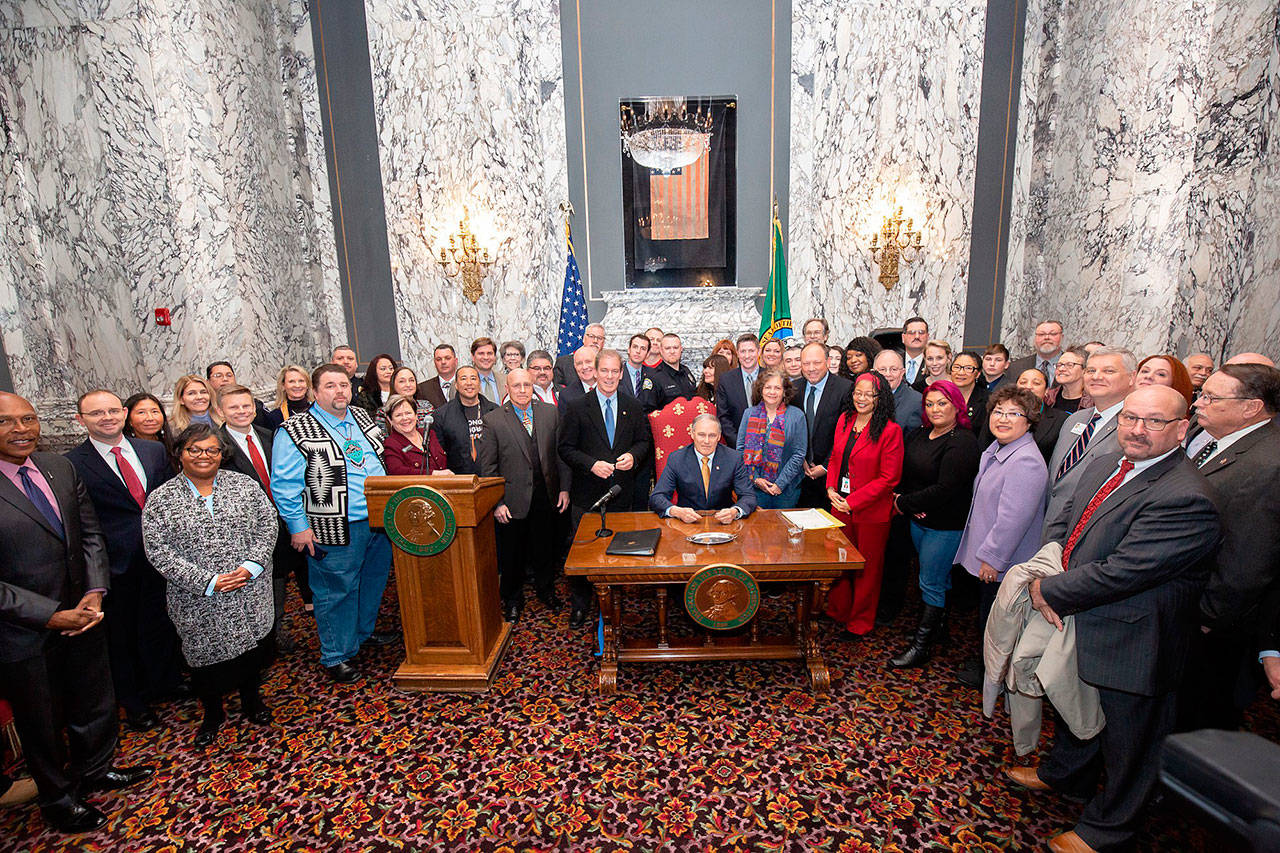Joined by dozens of legislators, law enforcement officials and community leaders, Gov. Jay Inslee signed a bill Monday that changes the law for use of deadly force by police officers and requires officers to take additional de-escalation training.
The new law (Substitute House Bill 1064) makes changes to Initiative 940, which voters approved in November. The bill results from a multi-year effort that brought community advocates and law enforcement together in an unprecedented collaboration on this issue, according to a Governor’s Office news release.
“This is a model for how the country can work through emotional and divisive issues,” Inslee said. “This bill — which passed unanimously out of both chambers — doesn’t fix everything. Far from it. But it’s a start. It’s a sign that we can have this conversation, and that something good can come of it. It’s a sign that we can indeed begin to dismantle and redefine our understanding of justice for all in America.”
This is the first bill Inslee signed from the 2019 legislative session.
The changes stem from concerns about use of deadly force in situations between police officers and the public. The bill modifies the standard for use of deadly force by law enforcement officers. The real value in the bill comes from the now-required violence de-escalation and mental health training, said Lynnette Buffington, executive director of the Washington State Fraternal Order of Police.
“Opposing sides heard each other out,” Buffington said. “This is an achievement we can apply to any political divide — if people are willing to hear each other out for an expended period of time, we might come to a place where we agree.”
Steve Strachan, the executive director of Washington Association of Sheriffs and Police Chiefs, said the signed bill represents one of the most ‘extraordinarily’ collaborative efforts between community advocates and law enforcement groups that he has experienced in his 34-year career in law enforcement.
“Frankly, I’ve never seen anything like it,” said Strachan, a former Kent Police chief.
Strachan, who represented law enforcement, was among those who sat at the table for intense discussions about the proposed bill. Andre Taylor, who lost his brother in a deadly force incident in 2016, brought a community advocate voice to the group. So did Tim Reynon, a member of the Puyallup Tribal Council whose tribe lost Jacqueline Salyers the same year. Legislators, police officers and other voices from community organizations such as De-Escalate Washington were also involved in the discussions.
The meetings often lasted anywhere from four to 12 hours. In the beginning, you could feel tension between the two groups, Reynon said.
Many attendees felt an emotional ‘us versus them’ mentality, according to Teresa Taylor, executive director from Washington Council of Police and Sheriffs. Although that mentality quickly decreased, she said law enforcement approached those initial meetings with an expectation to listen.
“It showed we respected the work they had done, the issues they brought forward, and that we really wanted to better understand their position,” Teresa Taylor said. “That was pretty powerful. It wasn’t just law enforcement coming to the table and demanding for something to be different.”
The Washington Post compiled state-by-state data of every fatal shooting by a police officer since 2015. The number of people fatally shot in Washington during 2017 rose to 38, which accounts for 4 percent of the nation’s 2017 overall count.
Over time, small victories for both sides started to emerge. Taylor said one of the turning points came during an extra-long meeting. Law enforcement members asked community members to leave the room so law enforcement members could find common ground around a certain issue before moving forward.
“They were out of the room for hours — hours — and they never left the building,” she said. “They stayed. There was never a moment when they said, ‘We’re leaving for the day until you figure it out.’ That’s powerful because it showed they saw the process as a holistic event and saw the important part of being available.”



